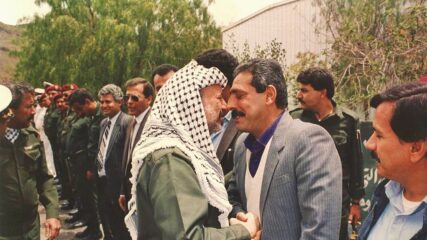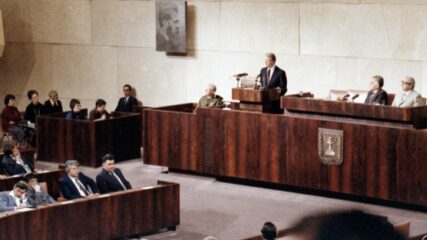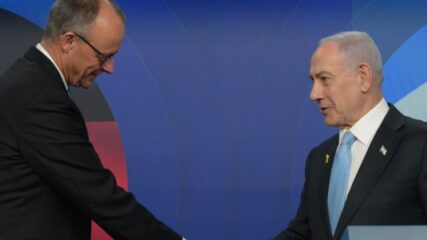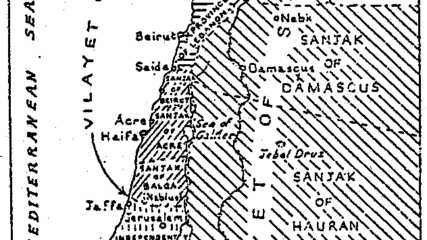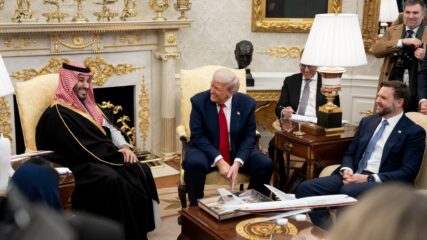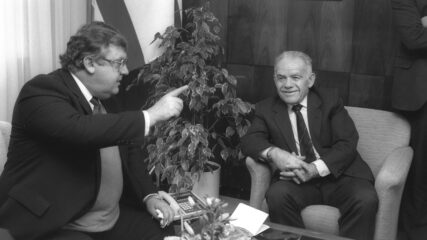Scott Abramson, November 2023
Throughout the history of their diaspora, the Jewish people had represented the definitive nation-in-exile and the quintessential minority, “the minority par excellence,” as philosopher Hannah Arendt described them. Jews had even held a monopoly on the word “diaspora” itself, which, until the late twentieth century, had been a proper noun that referred exclusively to Jews living outside their homeland. But then came the state of Israel, and with it, Zionism’s conversion of the Jewish people from a scattered stateless minority into an ingathered ruling majority. Such a change, viewed in the light of post-Second Temple Jewish experience, seemed an inversion of the natural order. After all, for the first time since the Maccabees, there existed a state in which Jews predominated both numerically and politically. The question naturally suggested itself: Now that “the quintessential minority” had become a majority with a state of its own, what of the non-Jewish minorities in the Jewish state?
To Zionism’s visionaries, this was not a new question, as the movement’s theoreticians since Herzl had engaged with it. In Political Zionism’s founding document, The Jewish State, Herzl stipulates that “if members of other faiths or of other nations reside among us, we will provide them with equal protection and rights under law.” Herzl affirmed this in fictional form in Altneuland, the utopian novel he penned six years later. In the future Jewish state imagined in the novel, a demagogic rabbi named Dr. Geyer runs for parliament on the promise of revoking the citizenship and the voting rights of non-Jews. In the end, a victory is won for liberal democracy, as Dr. Geyer’s electoral defeat rescues the non-Jews from the fate he’d intended for them.
Herzl’s was no lone voice among the Zionist intelligentsia either. On the contrary, his liberal vision of minority citizenship was shared by nearly all Zionist theoreticians after him, even the intellectual godfather of the Likud Party, Ze’ev Jabotinsky. In his last book, The Jewish War Front, published in 1940 after twenty years of open conflict between Arabs and Jews in Mandatory Palestine, Jabotinsky proposes a Jewish-Arab power-sharing formula for government in the Jewish state-to-be: “In every cabinet in which a Jew will serve as prime minister, the deputy prime minister will be an Arab, and vice versa.”
The liberal Zionist consensus on minority citizenship found official expression in Israel’s Declaration of Independence. Instead of referring to minorities in general, the proclamation singles out Israel’s Arabs, mentioning them specifically. To be sure, Arabs were far from being the newborn state’s only minority, but they were (and still are) much the largest; what’s more, since it was Israel’s Arabs who were engaged in or, at least, supportive of “the onslaught launched against us,” as declaration puts it, the newborn state’s Arab citizens stood in greater need of an assurance of their postwar safety. The Declaration of Independence thus urges Israel’s Arabs “to preserve peace and participate in the upbuilding of the State on the basis of full and equal citizenship and due representation in all its provisional and permanent institutions.” Whether the state and its Arab citizens have both lived up to the spirit of this call, fulfilling their part of this covenant, is, like everything else related to Israel, a matter of contention. For the state, the challenge is a balancing act, as Israel must reconcile its identity as a Jewish state with its identity as a liberal democracy, and it must reconcile its security needs with the rights of its non-Jewish–specifically, its Arab–citizens. The dilemma of Israel’s Arabs, for their part, is captured by the pronouncement of Abdul Aziz al-Zoabi, the Arab Knesset member who, in 1969, became deputy minister of health and, as such, the country’s first Arab minister: “My country is at war with my people.” How Israel’s Arab citizens have managed this dilemma has varied widely, as is illustrated by the contrasting examples of two Arab Knesset members from the same extended family. Throughout his tenure in the Knesset, Abdul Aziz Zoabi championed Arab-Jewish cooperation, repeatedly calling on Israel’s Arab citizens to contribute to the state. Speaking from the same rostrum years later, Haneen Zoabi, an MK from 2009 to 2019, praised Hamas and Iran, two seekers of Israel’s destruction, while counseling Israel’s Arabs not to accept Israel’s Jewish nation-statehood.
Israel’s Minority Landscape
There live some 2.5 million non-Jews in the Jewish state, almost a quarter of the country’s population. Minorities are to be found throughout the country, but they’re concentrated in the north, particularly in the Galilee region, while in Gush Dan (the Greater Tel Aviv Metropolitan area), their numbers are smallest. The majority of Israel’s non-Jews are Arab (twenty-one percent of the country’s population), and the majority of these, in turn, are Muslim (eighty-five percent). Thus, Arab Muslims, eighteen percent of the total population, are Israel’s dominant minority. In contrast to largely urban Arab Christians, Arab Muslims are an overwhelmingly rural population. Their three main areas of concentration are in the Galilee (the largest and northernmost), along the Green Line in the Samarian foothills (the “middle” of the three, both geographically and numerically), and in the Negev (the smallest and southernmost).
A subgroup of Israel’s Arab Muslims merits special mention because of its distinctive mode of life, the Bedouin. The Bedouin are the settled descendants of recently nomadic or semi-nomadic tribal herdsmen. Precise estimates are elusive, but it would seem they number about fifteen percent of Israel’s Arab Muslims. They live in Galilee and in the Negev, the latter hosting their largest concentration, and several hundred of them serve voluntarily in the Israel Defense Forces.
A tribal people like the Bedouin, the non-Arab Circassian minority is Israel’s other Muslim community, but with just 5,000 members, they’re not even one-percent the size of Israel’s Arab Muslim population. Israeli Circassians descend from ancestors who fled their North Caucasian homeland (the southernmost part of the Russian Federation) in the nineteenth century. Just a few years before the Tsarist pogroms that triggered the First Aliyah, the Russian Empire had been waging a genocide against the Circassians. (The Russian Black Sea resort town of Sochi, where the 2014 Olympics were held, is in the heart of historic Circassia, and the Olympic stadiums there were built, literally, on top of Circassians graveyards). Escaping the atrocities in Circassia, refugees from the genocide fanned out across the Middle East, settling throughout the region and in three villages in the Land of Israel. Two of these villages remain, and it’s there, in these two Galilean hamlets, that all Israeli Circassians are to be found. Like Israel’s Druze minority, Circassians are drafted into the Israel Defense Forces.
Israeli minorities who are not Muslim or Arab (or neither) are an especially varied lot, diversified by ethnicity, religion, language, and lifestyle. Among these are Israel’s 185,000 Christians. Though just two percent of the country’s population, Israel’s Christian communities are disproportionately wealthy and well educated, their impact on Israeli society much greater than their modest numbers might suggest. Israeli Christians include Armenians, Arab Christians of the Greek Orthodox, Melkite, and Latin Churches, Arameans (Maronites), as well as a multiplicity of Christian sects with no more than several hundred adherents. Protestants in Israel, as in the Middle East in general, are very few.
While virtually all Israeli Muslims are Sunnis–there being no community of Israeli Shia–four “post-Islamic sects,” offshoots of Islam that grew into altogether separate religions, have adherents in Israel. Of these, the largest and best-known is Israel’s 150,000-strong Druze community, the third most numerous religious group in the country after Muslims and Christians and less than two percent of the total population. Israel’s three other post-Islamic sects are much smaller and their communities confined to a single locality: 700 Baha’i in Haifa, 2,500 Alawites in the village of Ghajar on the Lebanese border, 2,000 Ahmadis in the Kababir neighborhood of Haifa.
Israeli minorities are further diversified by the depth of their roots in the country. Some Israeli minorities boast millennia of continuous settlement in the country while others have lived in the country for a single generation. Israel’s almost one-thousand Samaritans, an indigenous minority that sprang from the same stock as the Jewish people, can claim a continuous presence of three millennia in the land of their birth. But unlike the Jews, the Samaritans have never known the homelessness of exile. Israel’s Armenians, for their part, are not a native community like the Samaritans, but the longevity of their 1,600-year uninterrupted presence in the Land of Israel might as well make them “natives.” While many–and possibly even most–of Israel’s Arab citizens descend from ancestors (Jews, Samaritans, Aramaic-speaking Christians, Greek and Roman colonists) who lived in Palestine before the Arab conquest of the seventh century, these groups were reborn as Arabs after the Arabization and Islamization In any case, even if their only connection to their pre-Arab ancestors is genetic or, if they’re Christians, religious, they can still be considered natives.
Recent arrivals also number among Israel’s non-Jewish citizenry, like the several hundred Vietnamese “boat people” taken in by the Israeli government in the late 1970s.” A more recent and much larger community of asylum-seekers settled in Israel in 2000. When Israel withdrew from Southern Lebanon in 2000, dismantling its 22-year-old “Security Zone” there, the retreating soldiers were joined by mostly Maronite Christian evacuees. These veterans of the Israel-allied South Lebanese Army (SLA) and their families (some 6,500 people in total) found refuge in Israel. About half took Israeli citizenship, staying in the country permanently.
For some Israeli minorities, like Arab Muslims, Israel is their homeland; for others, like Arab Christians, it’s their homeland and their holy land, and for still others, like Armenians and Circassians, it’s merely a part of their diaspora, their homelands far afield. For the Circassians, there’s Circassia in southern Russia; for the Armenians, the Republic of Armenia, and for the Maronites, Lebanon.
For the Israeli government and for the minorities themselves, these transnational affiliations have sometimes been not so much ties as entanglements. The state of war between Israel and Lebanon, for example, has precluded Israel’s Maronites and Druze from making pilgrimages to their holy sites in Lebanon. Similarly, Israeli Muslims (Arabs and Circassians) were, at one time, the only adherents of their faith worldwide barred from fulfilling one of the five sacred obligations Islam imposes on every believer, the pilgrimage to Mecca. Contrary to Islamic custom, which prescribes that all Muslims be permitted to make the pilgrimage to Mecca regardless of any political or military conflict underway, the Saudi government refused entry to all Muslim pilgrims with Israeli citizenship until 1978, when the Jordanian government brokered a solution. Nor could Israeli Armenians and Circassians visit their homelands from 1967 to the late 1980s, when the Soviet Union, with which Israel then had no diplomatic relations, ruled over the two peoples’ homelands.
Commenting on the transnational ties of Israeli minorities, David Ben-Gurion once observed, “Israel isn’t a normal country because of the affinities of its people (Jews, Christians, and Muslims) with their co-religionists abroad.” Ben-Gurion had been particularly sensitive to international Christian opinion, and the much lower proportion of Christians than Muslims displaced in 1948 was a consequence of his concern. Nevertheless, the Vatican’s representations to the Israeli government on behalf of Israeli Catholic communities have often been an irritant in Israel’s ever-contentious relationship with the Catholic Church.
Jews in the Middle East outside Israel have not been the only ones persecuted on the pretense that they’re Israeli agents. The Iranian government, alleging espionage in the service of Israel, has persecuted Bahai on no better grounds than that the Bahai Faith’s headquarters are in Haifa. Though much less menacing, Israeli citizenship has even brought the country’s Arabs under suspicion by Palestinian and other Arabs, never mind that Israel’s Arab citizens overwhelmingly identify as Palestinians and embrace the Palestinian cause unreservedly. Israel’s Arab citizens have often told of being accused of treason by their kinsmen simply because they or their ancestors remained in the country in 1948.
Minorities and the State
Israeli law recognizes five religions (Judaism, Christianity, Islam, and the Druze and Bahai faiths) and ten Christian denominations. Israel has preserved the Ottoman system that permits each group (or millet as the Ottoman designated them) autonomy over its own religious affairs. Each of these communities, for example, has jurisdiction over matters of personal status (e.g., marriage and divorce) and administers its own courts. But whereas the Ottomans refused recognition to the post-Islamic sects derived but distinct from Islam–sects that the sultan’s Islamic empire considered heresies–Israel has extended recognition to two such groups: the Druze and the Bahai. The communal autonomy that this system ensures is especially dear to Israeli minorities, nearly all of whom wish to preserve their communal separateness and, thus, almost never marry outside of their community. Indeed, so strong is communal separatism/particularism among Israeli minorities that it could be said that if Israeli Jews have mixed together in a “melting pot”–a term coined, appropriately enough, by Zionist activist Israel Zangwill–Israeli non-Jews have lived separately in a “salad bowl.”
The identity card that Israeli citizens are required to carry at all times from the age of sixteen onward records the bearer’s religion but, since 2002, not his or her ethnic group. The ethnic group is still entered in the Interior Ministry’s population registrar, and the Interior Ministry allows the registrant a choice of almost 140 nations (leumim). This, though, is a rather confused list. Some of the entries are nationalities rather than nations, some of which (East Germany, for instance) are defunct, and some are religious, rather than ethnic, groups. The newest group to be entered in the list is the Arameans, Maronite Christians who don’t consider themselves Arab and don’t want the state to recognize them as such. After a seven-year campaign for recognition, the Israeli Interior ministry granted the Arameans’ petition in 2014.
Government responsibility for Israel’s minorities has changed over time and been divided between different ministries. In 1948, the infant country established two organs of the state responsible for minorities: the Ministry of Minorities and the Department of Christian Communities (within the Ministry of Religions). In 1949, however, squabbles within the government led to the abolition of the Ministry of Minorities and the creation of the Office of Arab Affairs as a part of the Prime Minister’s Office. Thus, the two bodies concerned with minorities were subordinate entities under the authority of the Ministry of Religion and the Prime Minister’s Office.
Non-Jews have been a part of state institutions since Israel’s founding. They have served in every Knesset, and they have voted in every Knesset election since the first in January 1949. In elections for the second through seventh Knessets, the proportion of Arab voters was in fact as high as or even higher than the proportion of Jewish voters. Two Christians and two Muslims have served on the Israeli Supreme Court, nine non-Jewish ministers and deputy ministers have served in Israeli cabinets since 1969, and seven non-Jews have been awarded Israel’s highest civilian honor, the Israel Prize. For a short spell in 2007, Majali Wahabi, a Druze officer turned politician, even served as Israel’s acting president. Seven non-Jews have been awarded the country’s highest civilian honor, the Israel Prize. Minorities are also spread throughout the civil and foreign service and the judiciary, among other state apparatus. To be sure, underrepresentation of minorities remains a problem in these and other bodies, but “positive discrimination” measures (“affirmative action,” as Americans say) have been adopted to boost minority numbers. In a few states institutions and bodies, minorities are in fact overrepresented. The Druze, for example, are overrepresented in combat units in the Israel Defense Forces and in the Israeli police (in fivefold proportion).
The Druze are not the only minority to serve in the IDF either. In 1949, the Knesset legislated that all non-Jews were to be exempt from conscription, but this dispensation did not find a welcome reception from all Israeli minorities. Within a few years, minority leaders had successfully lobbied the state to extend the draft to the males in their community, with the result that today all Druze, Circassian, and Samaritan men are subject to mandatory military service. Bedouin, Arab Christians, and Maronite/Arameans often serve voluntarily but on an individual basis.
The “temperature” of each Israeli minority’s relations with the state and Jewish society vary from community to community and generally correspond to their degree of integration in the state. The Druze, Circassians, Samaritans, Arameans/Maronites, and Ahmadis have, for the most part, enjoyed warm relations with the state and with Jewish society, something due, in no small part, to their military service and/or their non-identification with the Palestinians. Minorities’ voting preferences, like their willingness to enlist, likewise reflect their integration into the state. The Druze, Samaritans, and Circassians historically, and the Arameans more recently, have favored right-wing parties. In contrast, Israel’s Arab Muslims and, to a slightly lesser extent, its Arab Christians, often vote for Arab “protest parties.” Since Arab Muslims are, of all Israeli minorities, the most alienated from the state, they are also the most apt to identify as Palestinian. This hasn’t always been the case. In the first decades of Israeli statehood, they did not resist the designation “Arab-Israeli” that Israeli Jews applied to them. But since the late 1960s, amid the rise of Palestinian nationalism and contacts with Palestinians in the territories Israel gained in the Six-Day War, they have increasingly identified as Palestinians, spurning the term “Arab-Israeli.”


